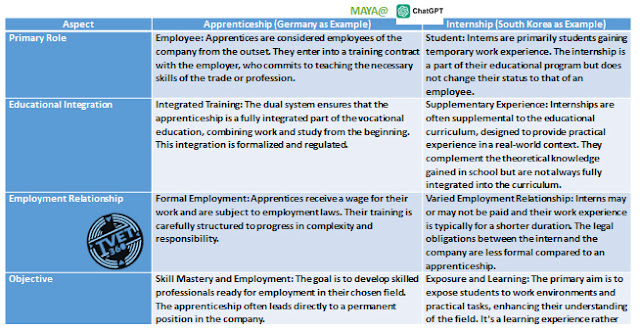7/07 - TVET Industry Engagement
 Nana Azhar
Nana Azhar
It’s time introduce to you to the TVET Apprentice and Intern.
The distinction between apprenticeships and internships often revolves around the student's primary role and the relationship between the training and their educational pathway. Here's a detailed explanation focusing on this aspect:
Apprentice as Employee vs. College Student as Intern

In summary, the key difference lies in the nature of the relationship with the workplace and the role of the experience within the educational journey. Apprenticeships treat the student as an employee first, with education and training designed around developing specific skills for a career in that field. Internships, on the other hand, view the student as a learner first, with the work experience aimed at enhancing their education and providing a taste of professional life without the same level of commitment or integration into a career path as found in apprenticeships.
Let's explore how TVET apprenticeships and internships are implemented within their respective systems
Germany: The Dual System (Apprenticeship Model)
Germany's TVET system is globally renowned for its dual system, which primarily focuses on apprenticeships.
Apprenticeships: In this model, students split their time between working in a company and studying at a vocational school. Typically, an apprentice will spend 3-4 days a week in the company, learning the trade hands-on, and 1-2 days at school, acquiring theoretical knowledge. This system allows students to earn a wage during their training, making it a highly practical and attractive pathway.
Integration and Certification: Apprenticeships are tightly integrated with Germany's vocational qualifications framework, and successful completion leads to recognized certifications. Industries and chambers of commerce play a key role in defining training standards and examinations, ensuring high quality and relevance to the job market.
Focus: The apprenticeship model is designed for direct entry into specific careers, with a strong emphasis on skilled trades and technical professions.
South Korea: A Blend of Internships and Apprenticeships
South Korea's approach to TVET includes both apprenticeship-like programs and internships, with recent efforts to enhance the practical training component of vocational education.
Specialized High Schools and Meister Schools: These institutions offer a blend of classroom instruction and hands-on training, with a growing emphasis on work-based learning. Meister schools, in particular, aim to revitalize the apprenticeship model by focusing on high-demand technical skills and closely collaborating with industries.
Internships: Internships are a significant component of vocational education in South Korea, especially in higher education institutions like vocational colleges and universities. Students are placed in companies for short-term work experiences, which may not be as integrated with their studies as apprenticeships. Internships often serve as a pathway to employment, providing students with practical experience and networking opportunities.
Government and Industry Collaboration: The South Korean government encourages partnerships between vocational schools, industries, and employers to ensure that training programs meet current workforce needs. This collaboration is evident in the design and implementation of internship programs, aiming to enhance job readiness among graduates.
Thank you for your time ❤️
Subscribe to my newsletter
Read articles from Nana Azhar directly inside your inbox. Subscribe to the newsletter, and don't miss out.
Written by
